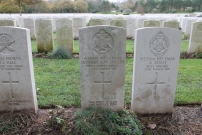| First Name: | Leonard Allen William | Last Name: | SPILLER | |
|---|---|---|---|---|
| Date of Death: | 27/03/1918 | Lived/Born In: | Lee | |
| Rank: | Rifleman | Unit: | London21 | |
| Memorial Site: | ||||
Current Information:17, Dacre Park, Lee Etaples Military Cemetery, France
In the Spring and early summer of 1918, the Germans launched four major offensives against the Allied line in France and Belgium which came close to ending the war in their favour. This was made possible by the end of the fighting on the eastern front after the Russian revolution, which allowed the German Army to bring its troops from there to France, where it was hoped a decisive effort would win the war in their favour before the Americans arrived in force. The Germans very nearly succeeded with their attacks. Their new tactics of a intense artillery barrage followed by groups of specially trained storm troopers forging swiftly ahead, by-passing any strongpoints, caused chaos among the defenders and remarkable gains in territory were initially seen. The old system of trench warfare soon became a thing of the past. But in each case the Germans over extended themselves and without adequate supplies keeping up with their rapid advances, they could go no further. By late summer, the Germans were exhausted, the Allies had regrouped and were then able to begin their own series of offensives which led to the collapse of the German Army and victory before the end of the year. The first of these attacks, Operation Michael, began on 21st March, 1918, when the German Army launched a major offensive, also known as the Kaiserschlacht (Kaiser's Battle) on the British line, running south from Arras to Chauny, close to the junction with the French Army. It was made by 63 specially trained divisions, attacking along a 60 mile front held by 26 British divisions, many of them in a weakened state. Aided by early morning mist during the opening days of the battle, the Germans made spectacular gains and within two weeks the British had been pushed back to the gates of Amiens. It was touch and go for the British Army who were in danger of being separated from the French and forced back to the Channel ports, but they rallied and with the agreement that Field Marshall Foch should co-ordinate all Allied movements, this worst case scenario was averted. At 4.40am on 21st March, all along the 50 mile front, the German artillery opened up with the most ferocious and concentrated bombardment of the war, the likes of which the British had never experienced before. The Forward Zone, consisting mainly of individual posts was blown away. Very few of the men there made it back. Many were killed and many more were taken prisoner. The Battle Zone was also battered as were the British guns, firing from positions just to the rear. Brigade and Divisional HQs were also targeted and then, from out of the thick mist came the German storm troopers. Moving fast, they skirted round the few remaining strongholds and penetrated deep into the British lines, including those of the Battle Zone, causing the utmost confusion. There were many cases of heroic stands being made but the relentless pressure forced the British back everywhere and there then began a general retreat that went on for two weeks and which ceded to the Germans a huge amount of territory, including all of that that had been won at such great cost during the Battle of the Somme in 1916. The Flesquières salient was a bulge into the German line just to the south-west of Cambrai and was formed as a result of the Battle of Cambrai in November, 1917. On 21st March, 1918 it was being held by V Corps and was not directly attacked. Instead the Germans tried to pinch it out by attacking either side of it. They did however plaster the whole front of the salient, held by 47th (London) Division and the 63rd (Royal Naval) Division with a sustained and heavy artillery bombardment, including many gas shells. The 21st London battalion of 140 Brigade, 47th Division were in reserve in the Villers-Plouich valley where they had to face a trench mortar onslaught. Despite the fact that there was no direct attack on the troops here it was soon realised that the salient had to be evacuated and 140 Brigade along with the other units began to move back. For 21st London this withdrawal began in the early hours of 23rd March when they withdrew under covering fire towards Ytres. They reassembled in vicinity of Vallulart Wood and marched to Le Transloy where at 3pm they took up positions on Four Winds Farm aerodrome. The enemy were following hard on their heels and immediately began to attack. The position held until dusk when they withdrew to a sunken road south of the village of Bus. The next day, 24th March, they fell back to Rocquigny where they held a line against considerable attacks until 2pm after which they moved yet further back via Le Transloy, Guedecourt and Martinpuich to Bazentin-le-Petit where they formed an outpost line. Still the pressure was maintained and on 25th March they withdrew to trenches covering Contalmaison. This line held all day but the enemy worked round their flanks and occupied Pozieres before nightfall, threatening their rear. The inevitable orders for a further withdrawal were issued and early on 26th March they fell back to Bouzincourt and that evening reached billets at Louvencourt. Among the many casualties suffered by 21st London during these chaotic few days was Leonard Spiller who died from wounds on 27th March after having been taken back to a base hospital on the coast. |
||||
| « Back to Search Results | ||||
| If you think any of the information shown here is incorrect, Click Here to submit your amends and comments | ||||




